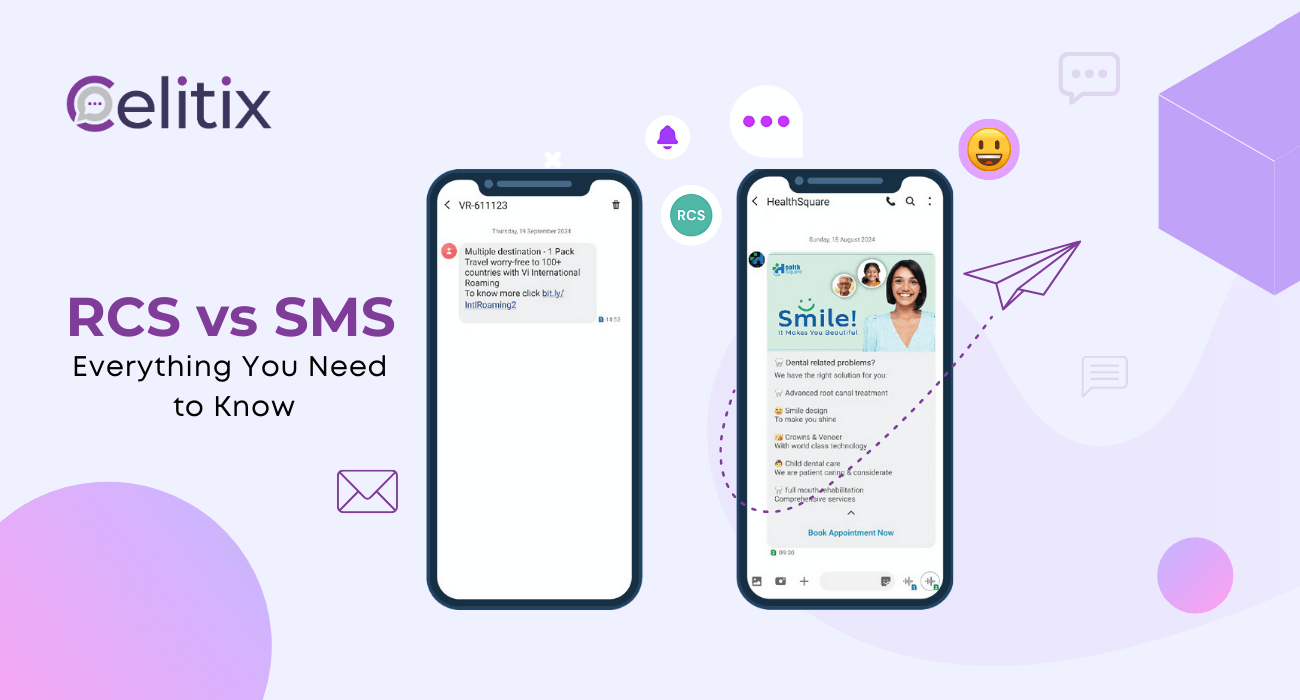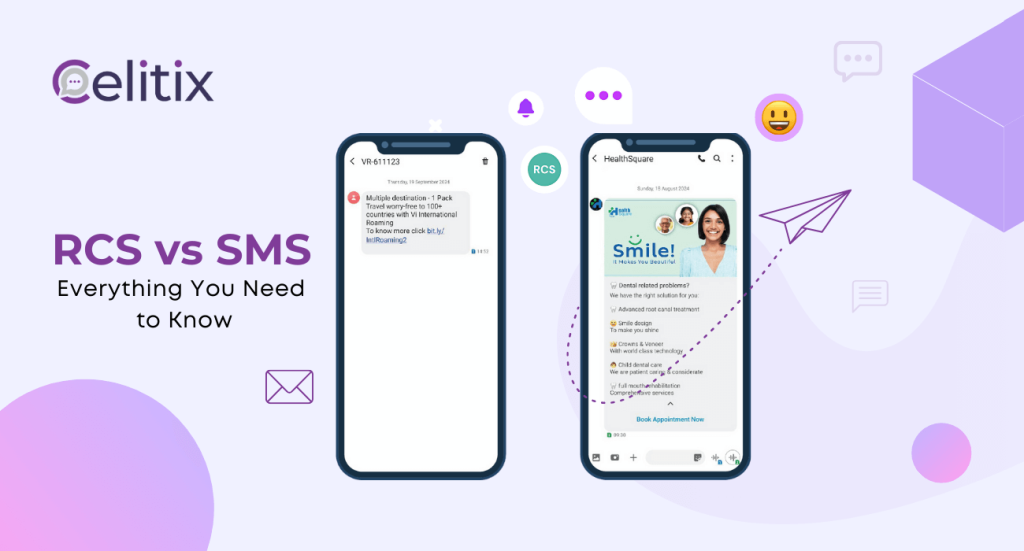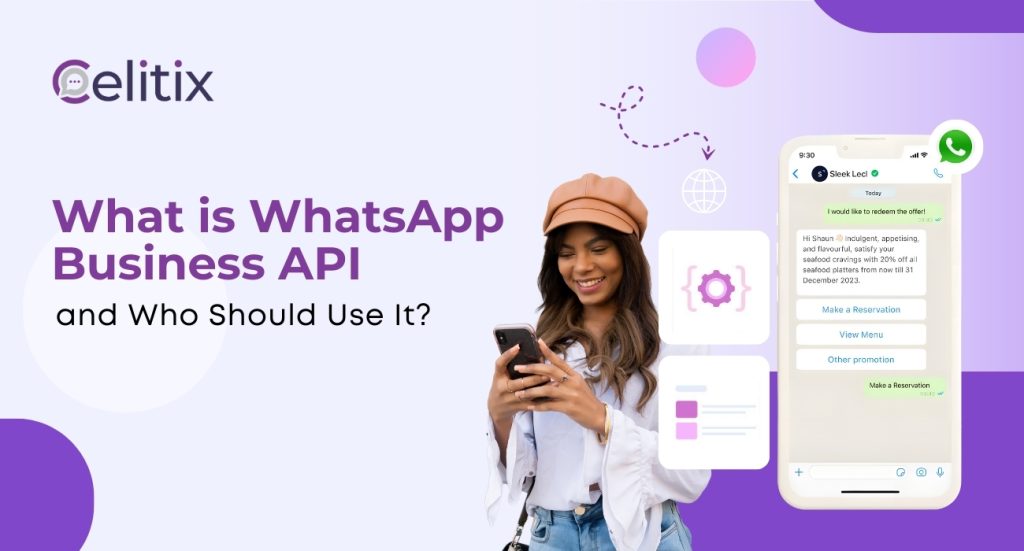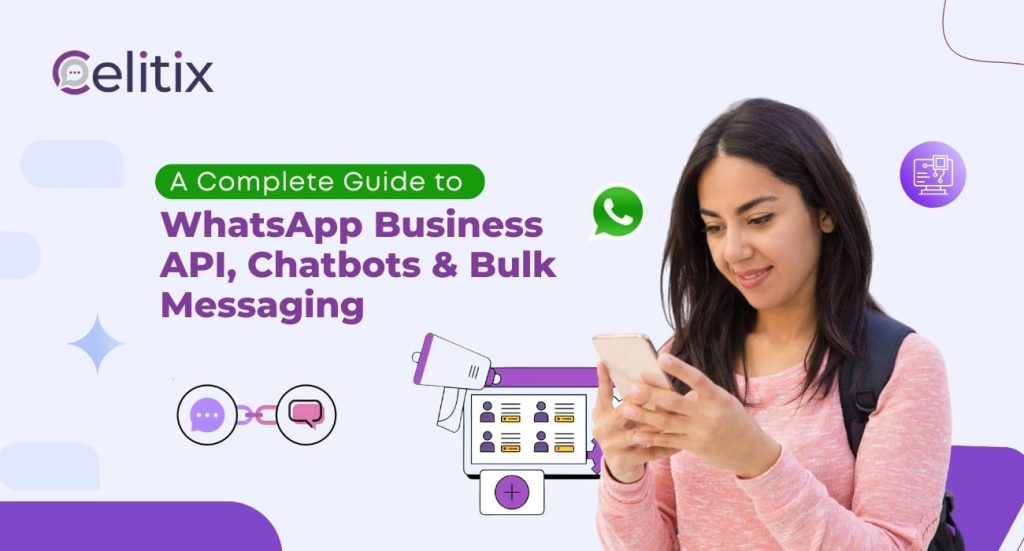Most people don’t associate RCS vs SMS with digital marketing, often considering SMS a dead or dying channel for branded communication. However, in reality, much like essential technologies and modern infrastructure, SMS is taken for granted.
RCS vs SMS highlights the evolution of messaging technology. RCS, popularised in 2016, is an upgraded version of SMS that builds upon the functionality of native messaging apps to offer features comparable to OTT messaging apps like WhatsApp.
For any business that wishes to scale, it is essential to understand the potential as well as the limitations of both these native messaging services. As a result, decision-makers can develop better strategies that win.
Let’s dive right in.
What is SMS & How Does it Work?

Short Message Services (SMS) are the primary way to text, and they are available on every mobile phone, as soon as one inserts an active SIM card. When used through native messaging apps, they rely on the mobile network to effectively send and receive text messages.
In fact, it’s the same technology used for making voice calls, which means it doesn’t require an internet connection. SMS has been around since 1990, and is by far the most widely used standard of mobile texting today.
While underrated, SMS plays an essential role in modern-day communication, which is often taken for granted. In addition, decision-makers should appreciate the wide accessibility and instant reach of this messaging channel, as it is a powerful tool for communication.
Users keep their mobile numbers private, which makes SMS perfect for time-sensitive communication that builds trust. For instance, OTP verifications, transactional messages, notifications, and updates are good examples.
SMS might not be exciting, but even well-planned promotions can prove useful. It’s essential to respect user privacy by strictly adhering to opt-in requirements via two-way SMS broadcasts.
With Celitix, a well-planned strategy and sales funnel, SMS can be combined and integrated with Missed Call Services, IVR (Virtual Receptionist), and more to achieve outstanding results for various organisations.
However, it does have limitations. An SMS message is limited to 160 characters since it works over the mobile network. MMS can also be used, but are rarely useful for business or organisational needs.
What is RCS & How Does it Work?

Rich Communication Services (RCS) was developed by GSMA in 2008 as the next generation of text messaging. It became widely available in 2016 when Google bought Jibe to offer RCS worldwide. (learn more about the evolution of texting)
The most important thing about RCS is that it offers all the rich messaging features of things like iMessage & WhatsApp on a mobile’s native messaging platform. These features include:
- Rich Messaging Features: For example, media sharing includes HD images, videos, audio files, PDF documents, and more, all with larger file sizes and additional character support.
- Security Features: End-to-end encryption, verified brand profiles regulated by network providers.
- Engagement Features: Read receipts, typing indicators, group chats, location sharing, GIFs, audio messages, & more.
- Business Features: Brand profiles (links, logo image, name, location), brand colours, action buttons, carousel messages, promotions, fallback channels, & more.
These features build upon SMS to offer better text messaging experiences on native messaging apps. RCS also offers carousel messages and chatbots that work wonders for promotion & support if used well.
RCS offers many benefits to organisations, with cross-platform compatibility since the launch of iOS 18 in September 2024. However, its limited adoption also poses significant challenges.
Let’s differentiate between these two channels before exploring which channel might be best for you.
RCS vs SMS vs MMS: Key Differences

RCS vs SMS emphasises not only that RCS is the latest technology poised to replace SMS in the future, but also highlights a few technical nuances that need consideration. Additionally, MMS should be included in the discussion, as it remains a part of SMS functionality.
User-Perspective:
|
Feature |
RCS |
SMS |
MMS |
|
Media Support |
HD Images, Videos, Audio, GIFs, & Stickers |
Text-only (160 character limit) |
Low-res images, short videos, & audio clips |
|
Group Messaging |
Yes (Comprehensive) |
No |
Yes (Basic) |
|
Security |
Good |
Limited |
Limited |
|
Read Receipts |
Yes (if supported by both sender & receiver) |
No |
No |
|
Typing Indicators |
Yes |
No |
No |
|
Cost to User |
Data Charges only |
Per-message cost (carrier-dependent) |
Higher per-message cost (carrier-dependent) |
|
Ease of Use |
Seamless with supported apps (Google Messages, iOS 18) |
Simple & Reliable |
Inconsistent due to network & device limitations |
Business-Perspective:
|
Feature |
RCS |
SMS |
MMS |
|
Network Dependence |
Needs Compatible Carrier + Internet |
Works on any cellular network |
Works on any cellular network |
|
Cross-Platform Support |
RCS-Enabled Android & iOS 18+ Devices |
Universal compatibility across devices |
Universal compatibility across devices |
|
Adoption |
Growing, but fragmented (carrier-dependent implementation) |
Universal, widely supported |
Universal, but declining usage |
|
Reliability |
Highly reliable in good network conditions |
Reliable even in poor network conditions |
Inconsistent |
|
Fallback Channel |
SMS/MMS if RCS is unavailable |
N/A |
N/A |
|
Use Cases |
Payments, Verified Profiles, Bookings, Support, Rich Ads, Feedback, & more |
OTP, text alerts, & reminders |
Basic promotional campaigns |
|
Cost to Company |
Less than OTT messaging |
Most affordable |
Not worth investing in |
Technical Comparison:
|
Feature |
RCS |
SMS |
MMS |
|
File Size |
20-105 MB (Carrier dependent) |
160 Bytes (Text-Only) |
300-600 KB (Carrier dependent) |
|
Delivery Mechanism |
Internet-based (uses mobile data/Wi-Fi) |
Cellular network-based |
Cellular network-based |
|
Media Compression |
Minimal (retains high-quality) |
N/A |
Heavy compression |
|
Encryption |
End-to-end (Depends on App & Carrier) |
No |
No |
Key Takeaways:
In a nutshell, here are the biggest things to keep in mind when comparing SMS, RCS, and MMS from a business perspective:
- RCS: Differentiate yourself from the competition in key metro/tier 1 cities. Key to the future of text-based communication, sales, support, and marketing. With chatbots, rich features & integration, this channel might change how people interact via text as it gets more widely adopted.
- SMS: The current standard of text messaging. In addition, it offers the widest reach and affordability. Furthermore, it’s perfect for OTPs, transactions, and alerts. It can be used for promotion, feedback, & support by integrating it with other services (like 2 way SMS, Missed Call Services, & IVR).
- MMS: Passes as a fallback mechanism, but is extremely limited. Unreliable with only about 500 KB file size, high compression, and inconsistent delivery due to carrier availability & implementation.
SMS: Pros & Cons for Business
Advantages of SMS for Business:
- Moreover, an easy, instant, and direct way to reach your customers.
- The most accessible, reliable (cellular network-based), and affordable text messaging solution.
- Use it to verify via OTP, promote with coupons, provide updates, and notify about transactions.
- Build customer trust while also positioning your brand as a prominent, long-lasting company.
Challenges of SMS for Business:
- Lack of customisation and features.
- Difficult to provide rich customer experiences.
- 2 Way & long/short codes have to be purchased separately.
- Per message cost to brands. While the price is low, each message is still charged.
RCS: Pros & Cons for Business
Advantages of RCS for Business:
- Moreover, rich, interactive, and engaging messaging experiences include HD media sharing, CTA buttons, read receipts, typing indicators, and more.
- Enhanced promotions, onboarding, & more.
- Additionally, verified brand profiles come with profile images, brand colours, and links for a professional touch.
- No need to invest in long/shortcodes or 2 Way Messaging separately.
- Furthermore, there is massive potential to craft exceptional experiences with custom chatbots that effectively enhance sales, bookings, support, engagement, and marketing.
- All this, on the user’s native messaging app.
- Moreover, it’s a great way to differentiate your brand from the competition while also building a real connection with your audience.
- Large file sizes & group messages for up to 100 people. The technology allows for sharing files up to 105 MB, but most networks only allow 10-20 MB for business needs.
Challenges of RCS for Business:
- Not widely adopted. Mass smartphone penetration is limited to metro & tier 1 cities, despite RCS compatibility on iOS 18 since September 2024.
- Carrier dependency. Since RCS is far from being the norm in India, there is a lot of dependency on network providers regarding what is possible.
- Requires an internet connection, which is far less widely available than the cellular network.
- Higher per-message cost than SMS.
RCS vs SMS: Which One Is Better For You?
RCS vs SMS reveals that while both are effective communication tools in a brand’s arsenal, they may not suit everyone. For instance, small businesses and startups might find both channels unfeasible to meet their specific needs.
SMS is ideal for large organisations that need to interact with hundreds of people daily. It is still one of the best channels for OTP & transactional communication, especially if you have an app or website.
RCS vs SMS showcases how RCS provides a unique opportunity to differentiate a brand in a competitive market. Moreover, large organisations can use RCS to build personal relationships with customers in key metropolitan areas or tier-1 cities.
Best Use Cases For RCS vs SMS

Once again, let me neatly summarise the ideal use cases for each of these channels:
SMS Use Cases For Business:
- Urgent notifications, two-factor authentication, & broad-reach campaigns where simplicity is key.
- Feedback & other things are also possible using links, but links on SMS are increasingly viewed as risky.
RCS Business Messaging Use Cases:
- Indeed, perfect for high-engagement communication, RCS allows businesses to elevate product demos, furthermore, enhance customer support, and additionally, deliver personalised promotions with rich visuals.
- Chatbots on RCS go far beyond mere automation. For example, a custom chatbot was developed for the biggest African football tournament to provide live updates to users and answer match queries in real time.
- Rich media and verified brand profiles can increase the effectiveness of promotions, enhance onboarding procedures, solve queries and more.
SMS vs RCS: Impact on Business

RCS vs SMS highlights that while SMS is ideal for time-sensitive and wide-reaching communication, on the other hand, RCS excels at differentiating your brand in a competitive market, setting it up for future success.
We suggest combining both, especially in key metro cities where mass ads can get drowned out in a flood of white noise. Sometimes you need to reach all your customers urgently, while a more personalised approach is best at other times.
Either way, native text messaging offers an opportunity to meaningfully connect with your target groups, retain your customers, and keep them engaged by utilising your customer database.
RCS vs SMS emphasises the importance of respecting opt-ins, especially with the growing hype around RCS and the surge of mass promotions. Unsolicited promotions, while tempting, can foster ill will and harm brand reputation.
When everyone is tooting their own horn, the few that respect the user’s attention and provide them value will shine even brighter. To begin with, get creative with your promotions and, furthermore, build your database with a sincere service mindset to ultimately ensure success.
Conclusion
In today’s rapidly changing world, decision-makers are responsible for doing everything in their power to improve their organisation’s chances of success. Consequently, they must stay proactive and also embrace innovative strategies to adapt effectively. Therefore, they must stay proactive and adaptable.
Furthermore, RCS vs SMS demonstrates how leveraging technology enhances your brand experience, while also offering compounding returns to your business. Furthermore, these two channels are essential tools in your communication arsenal, each currently ideal for specific purposes.
When attention is scattered and the future uncertain, an educated, diversified, & strategic plan can help achieve your company’s objectives. By focusing on your customers, putting them at the forefront of your strategy, and as a result, you’ll never go wrong.
Would they prefer to do certain things on a mobile app? What’s the best way to communicate specific things with them? How can you provide the best experience possible? That’s how you win in the long run.
In addition, Celitix empowers companies to build their apps and platforms quicker, easier, and most importantly, more affordably. It also helps small to medium organisations simplify communication and skyrocket their results.
Frequently Asked Questions (FAQs)
Q1. What is the primary difference between SMS and RCS?
SMS is a simple, text-only service provided through a mobile phone’s cellular network, while RCS supports multimedia and interactive features but requires an active internet connection/mobile data.
Q2. Is RCS more expensive than SMS?
Yes, RCS tends to cost more but offers richer engagement, making it valuable for campaigns that need interaction & differentiation.
Q3. Can all users receive RCS messages?
No, RCS is currently limited to certain carriers, while SMS works universally. Since RCS compatibility was launched for iOS 18 in September 2024, more users are technically able to receive these messages.
Q4. Which is more secure, SMS or RCS?
RCS offers verified profiles and end-to-end encryption, adding an extra layer of security which SMS lacks. Although the encryption depends on RCS’s implementation by the network service provider.
Q5. How can I start using Celitix for SMS and RCS?
Contact Celitix for a demo and explore how our platform simplifies RCS and SMS management.





